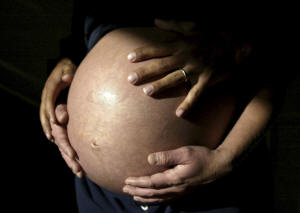Racial gap widened in deaths among US moms around the time of childbirth
 Send a link to a friend
Send a link to a friend
 [February 06, 2025]
By MIKE STOBBE [February 06, 2025]
By MIKE STOBBE
NEW YORK (AP) — Black women in the U.S. died at a rate nearly 3.5 times
higher than white women around the time of childbirth in 2023, as
maternal mortality fell below prepandemic levels overall but racial gaps
widened, according to federal health data released Wednesday.
In 2021 and 2022, the maternal death rate for Black women was about 2.6
times higher than white women.
The data suggest that the COVID-19 pandemic, at its peak, impacted all
pregnant women. But “once we went back to ‘usual activities,’ then the
impact of systemic racism and unequal access (to medical care) ... came
right back into place,” said Dr. Amanda Williams, interim medical
director for the March of Dimes.
The Centers for Disease Control and Prevention's report Wednesday on the
2023 deaths was drawn from death certificates. The CDC counts women who
died while pregnant, during childbirth and up to 42 days after birth.
Accidental deaths are excluded.

The report found:
— The maternal death rate for white women dropped from 19 deaths per
100,000 live births in 2022 to 14.5 per 100,000 in 2023.
— The rate for Black women went from 49.5 to a little above 50, though
the report says that increase was not statistically significant.
— The rate for Hispanic women dropped from about 17 to about 12.
— The rate for Asian Americans fell from about 13 to about 11.
In total, 669 women died in 2023 during pregnancy or shortly after
childbirth, the CDC reported. That’s down from 817 deaths in 2022 and
1,205 in 2021, when it was the highest in more than 50 years.
[to top of second column]
|

A couple awaits the arrival of their first child in Carlsbad,
Calif., in November 2005. (AP Photo/Julie Busch, File)
 Excessive bleeding, blood vessel
blockages and infections are leading causes of maternal deaths.
Among those infections is COVID-19. The coronavirus and its
complications proved dangerous to pregnant women. And, in the worst
days of the pandemic, burned out physicians may have added to the
risk by ignoring pregnant women’s worries, experts say.
COVID-19’s overall impact on pregnancies declined as the pandemic
subsided and as hospitals and birthing centers returned to normal
operations.
Also, the federal Medicaid program expanded to cover postpartum care
for up to 12 months, instead of just seven weeks. That helped more
moms recover and made them healthier for the next time they tried to
have a baby, Williams said.
The number of maternal deaths is also tied to the number of
pregnancies. U.S. births have been declining, and fewer pregnancies
contributes to fewer pregnancy-related deaths, noted Eugene Declercq,
a maternal deaths researcher at Boston University.
CDC officials refused an Associated Press request to talk to a
report author.
The government is still receiving and processing death reports from
last year. But Declercq said his analysis of available data suggests
the number of 2024 maternal deaths may end up about the same as
2023.
All contents © copyright 2025 Associated Press. All rights reserved |